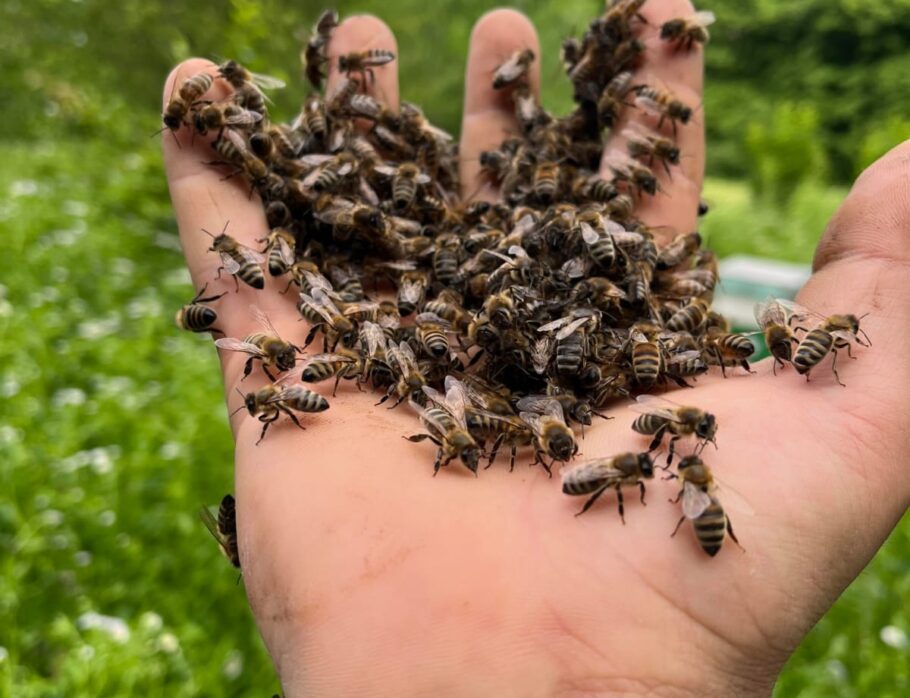The first sweetening agent discovered by humans was honey. Honey has been used extensively in food and medicine ever since we first began learning about its benefits.
In Spain’s Valencian cave, honey was first identified. Arana Caves in Spain have a cave painting that dates back 8000 years that shows a honey seeker. This ancient painting depicts a person taking honey from a wild beehive, proving that honey harvesting has been a practice among humans since at least 5000 BC. Given all the knowledge and experience gained over the years, there is new technology and improved methods for collecting honey today. Are the methods for collecting honey ethical, though, remains a question.
What it Signifies.
Simply put, ethical honey harvesting involves taking honey directly from natural beehives without harming the bees. This is how honey is traditionally extracted in India; it has a long history and is still used today. The practice of gathering honey in urban areas has proven to be profitable commercially as a result of population growth and the migration of people from rural to urban areas.
Beekeeping in the countryside.
It is primarily carried out in rural areas with low population densities, where agriculture is the main source of income and the bee hives are situated outside of urban areas. As they are closer to forests, taller trees in an undisturbed environment are what bees typically prefer. These environments can be found in rural areas. The quality and therapeutic properties of honey are impacted by the nectar that bees collect from a variety of rare medicinal flowers that are not typically found in urban areas.
The Ahimsa Forest Honey Collection (AFHC) method was developed by the Centre for Bee Development (CBeeD) for environmentally friendly honey production. In the new AFHC method, which has been adopted by more than 18,000 tribal members, honey hunters in the tribal areas are taught to gather honey in a non-toxic and moral manner to protect both bees and humans. The honey pursuer is given protective gear so they won’t get stung. The beehive is divided into pieces, one of which is chipped to release the honey, and the other is left whole to hold the eggs and larvae. With their work on the comb continuing, the bees are able to stay put at their current location.
The statistics of the activity were found to be being impacted by the urban areas’ rapid growth and expansion.
Beekeeping in Cities.
As the name implies, it is beekeeping in urban areas. Over time, this beekeeping technique has proven to be a potentially profitable idea for the agricultural sector. According to a study by the Royal Society Publishing, bees kept in urban areas tend to be healthier and better cared for, have larger colonies, and are less likely to contract diseases, all of which extend the bees’ lifespan and increase their productivity.
The impact of harmful pesticides on bees is a further point worth mentioning. The quality of the honey is also impacted by the pesticide use on the flowers that bees collect nectar from. In urban areas, bees are less likely to be exposed to any harmful chemicals.
Compared to rural beekeeping, this approach seems a little different. In this type of honey harvesting, hives are established on building rooftops and occasionally even in backyards, in contrast to the rural sector where hives are typically found in dense forests. The Langstroth hive and the top bar hive are the two main types of hives used in urban beekeeping, with the former being the more common type.
Langstroth Hive.
The reverend Lorenzo Langstroth created this pattern sometime in the middle of the 1800s. The beehives in this design are constructed from a series of rectangular boxes with movable frames. The movable frames in this hive are its most impressive feature and are what gave rise to this method of beekeeping. After the chambers are filled with honey, the frames are removed so that honey can be extracted without destroying the honeycomb. The most popular beehive setup in use today is the Langstroth hive.
Top Bar Hive.
The top bar hive is the most traditional hive design still in use today. Beekeepers don’t have to lift cumbersome boxes when using a horizontal top bar hive because these individual bars are placed across the top of the hive cavity. The bees naturally construct their comb from these bars, without the aid of a four-sided frame, allowing us to see through the functional window of the hive. The comb can be removed more easily thanks to this design.
The impact of beekeeping on the environment.
Beekeeping has long provided both people and biodiversity with numerous advantages. There are many positive environmental effects that bees motivate now that there is an increase in honey harvesting initiatives in both urban and rural areas.
Beekeepers place a high priority on forest conservation because beehives are found deep within forests.
Bees also play a crucial role in ecosystem development by serving as pollinating organisms, which improves tree regeneration and preserves the biodiversity of the forest.
Pollinators like bees enable a variety of tree species to flourish, including willows and poplars.
In addition, there are many different bird species, including the starling, blackbird, and ruby-throated hummingbird. eat the bees as food. Bees are a significant component of the diets of many different insects.
Some Advice for Harvesting Honey Ethically.
Keeping beekeepers safe and preventing any harm to the bees from happening should always be a top priority.
Because the health of the colony affects the quality of the honey, the bees should be given proper care.
In order to preserve the honey’s flavor, care must be taken when harvesting it traditionally to avoid directing smoke at the hive for an extended period of time.
Use protective equipment with caution to keep yourself safe.
